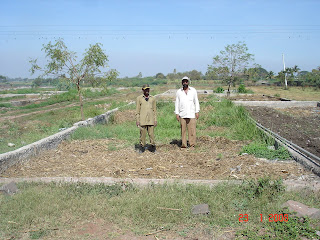




Fundamentally ‘vermicomposting’ represents one of the most ‘Earth Friendly’ ‘Ecological Sanitation’ solutions and no wonder many agencies and individuals are enamoured with the docile earthworms with regard to their capacity to convert kitchen waste (as against mixed municipal solid waste) into useful compost. There is no doubt about the capability of earthworms to devour the food left-over and other vegetable waste and in the process deliver a very homogeneous, uniform, pleasant textured and sweet smelling compost. However, in order to deliver such a high quality product, the earthworms need a great deal of care and protection. A number of well intentioned initiatives at the level of individuals, communities and even municipalities have been discontinued due to a number of external risk factors. A set of concerns, problems and risk factors are described hereunder:
- Earthworms are very sensitive to temperature variations and require humid and shady place to work effectively. Temperature within the vermibeds/waste piles needs to be maintained within the ideal range of 20-28°C otherwise the earthworms start dieing. Typically in peak summer and winter seasons a higher rate of die-off is observed if the vermibeds are not well covered and protected. Secondly, aerobic composting being an exothermic process where the temperature in the core of a high waste pile rises beyond 55°C, it does not offer a very conducive environment for earthworms to survive. It is essentially to avoid heat build up that it is recommended to use (a) pre- or semi-digested organic waste, (b) restrict the height of vermibeds as low as 30-45 cm, (c) provide a shed of thatch and (d) cover the vermibeds with moist gunny bags to keep the army of earthworms cool.
- The requirement of feeding pre-digested food waste entails provision of a pre-processing section with 15-30 days holding capacity. Secondly restriction on height of vermibeds (as against large windrows) translates into large area requirement for a community level treatment facility. Easy availability of land is a limitation and therefore either the throughput is restricted or the vermibeds get overloaded. A combination of overload and raw waste as feedstock results in higher die-off of earthworms.
- Earthworms are also not comfortable under high moisture conditions. In monsoon an uncovered facility experiences higher die-off.
- Earthworms are easy targets of predators and therefore vermibeds need to be well ‘guarded’ against centipedes, snakes, rodents, birds, hens and red ants. Generally to avoid ants, every vermibed has a ‘moat’ of water all around !!
- It has been found that the indigenous species and soil burrower category of earthworms are not effective for direct devouring of kitchen waste. Exotic species such as Eudrillus euginiae, Eisenia foetida and Perionyx excavatus which are found to be most suitable are required to be cultured or purchased. The market rate of exotic species varies between Rs. 300 – 1000/kg of earthworms. Given the risk of predation and sensitivity to climatic factors, no wonder some agree-entrepreneurs are more interested in selling the earthworms rather than setting up a vermicomposting operation !
Once an individual or a large facility operator experiences colony die-off, he/she does not get second time motivated to procure a new batch of earthworms at the prevailing market rates and recolonise the vermibeds. There are so many uncertainties involved. And to ward them off, a good deal of care is required. Because of these reasons, it is generally found that sooner or later most of the vermicomposting initiatives are abandoned.
Further, because of the inherent uncertainties, the vermicomposting systems are not suitable for scaling up to treat large quantities of mixed MSW at ward or city level. It is understandable that these very reasons contributed to abandoning of a plant which was ambitiously designed for 400 MT/day capacity at the Devnar landfill site in 1992-93 in Mumbai.

No comments:
Post a Comment